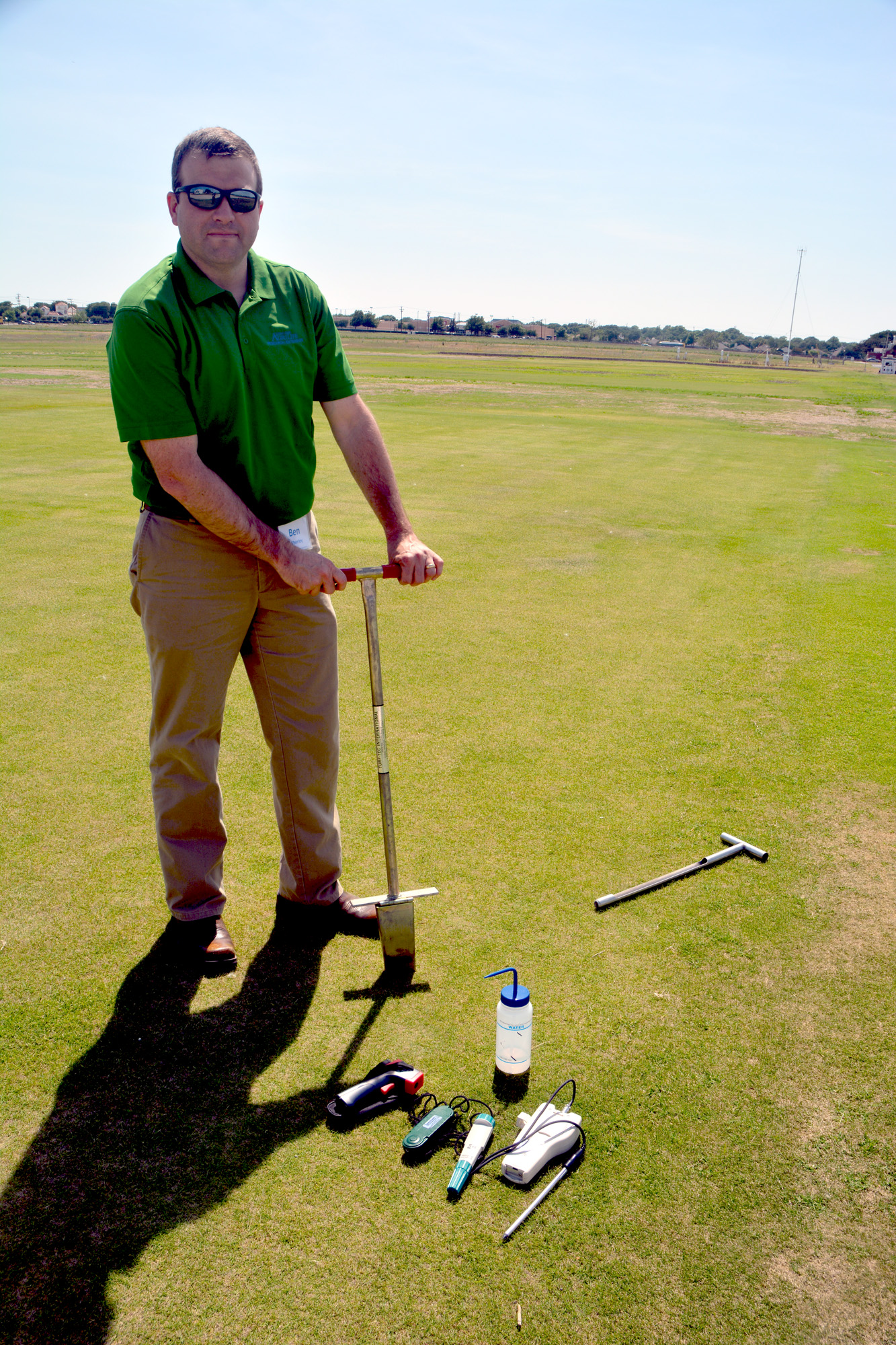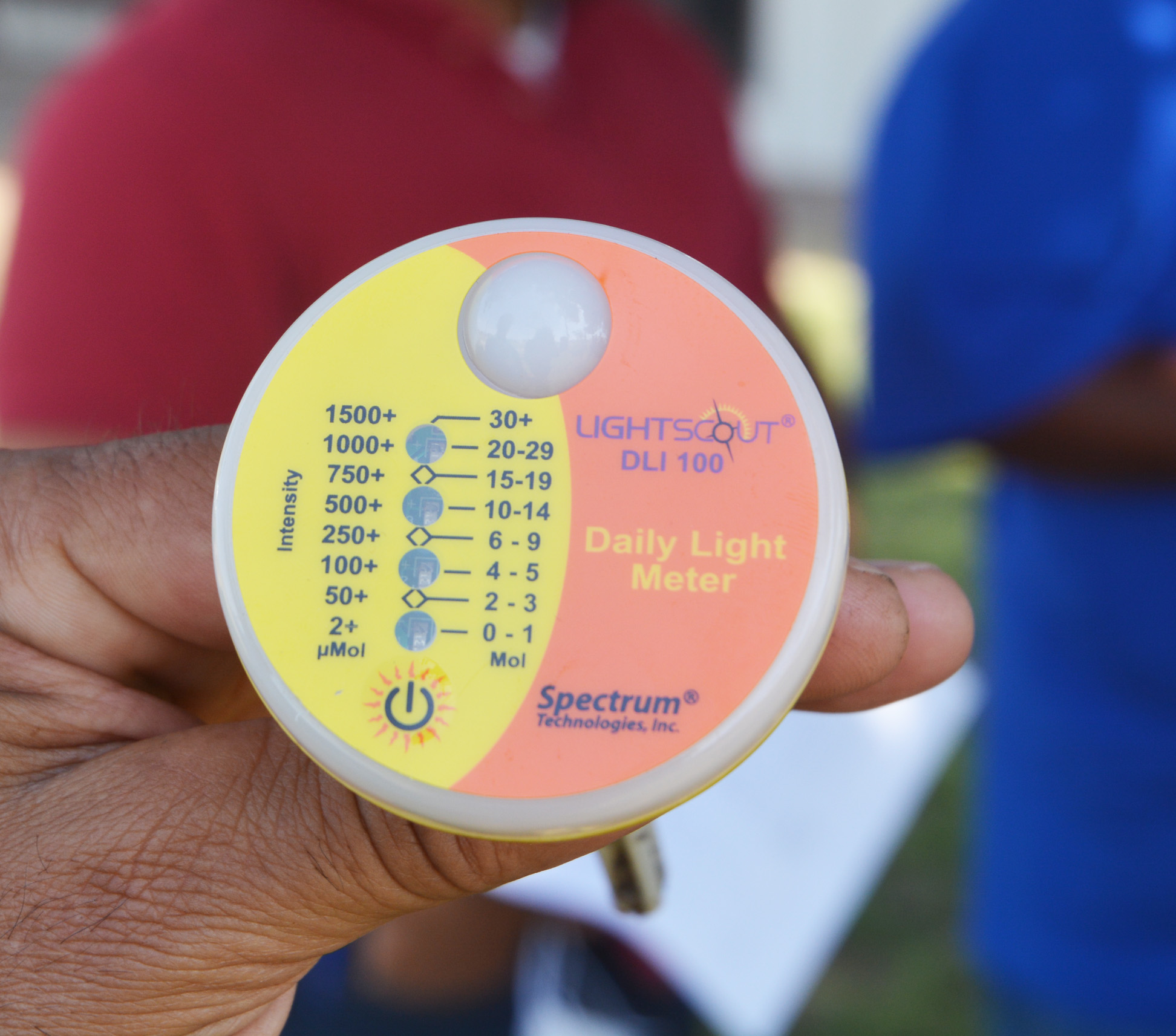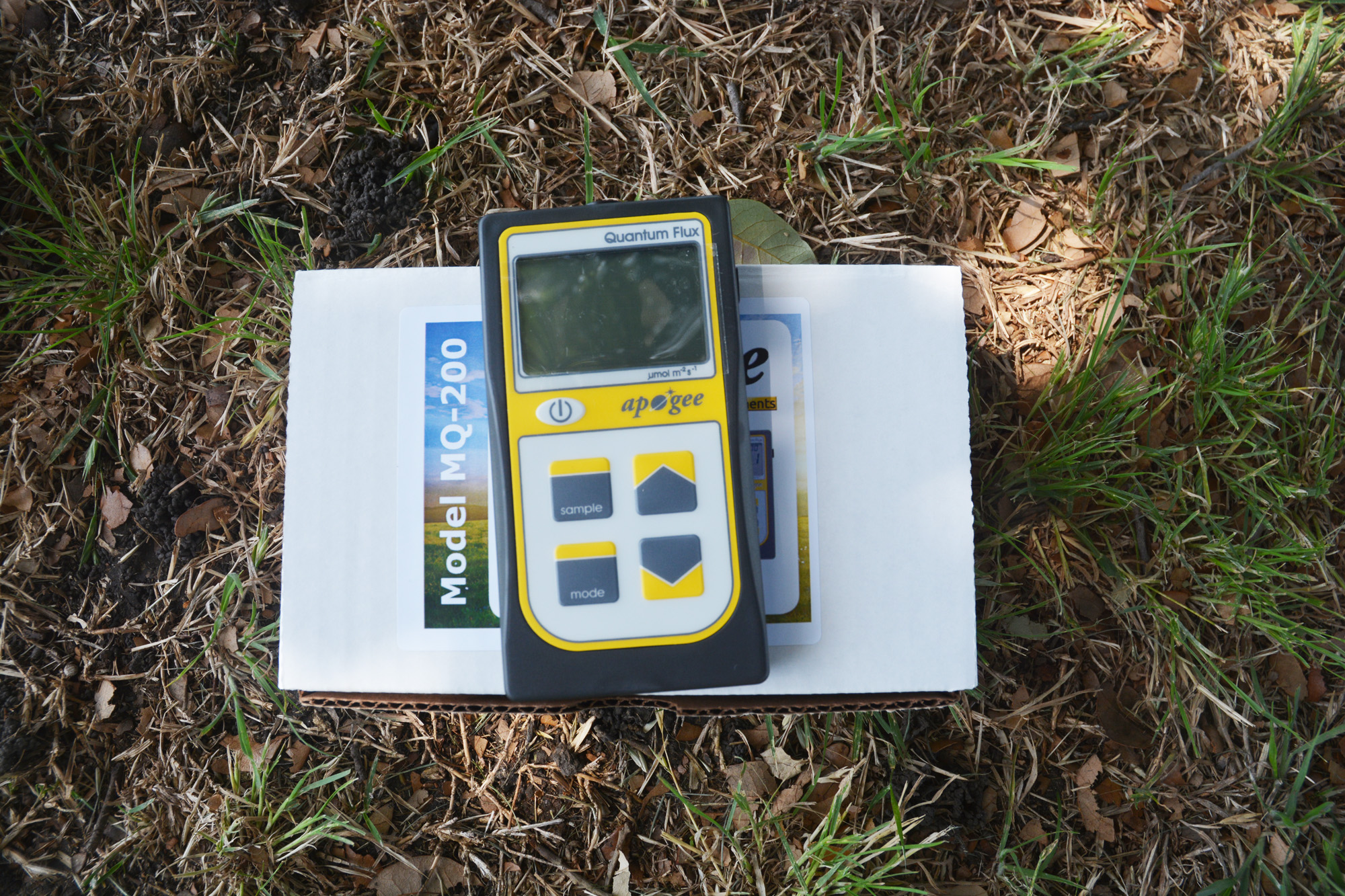Dallas, Texas, USA
June 5, 2014

Dr. Ben Wherley, a Texas A&M AgriLife Research assistant professor for turfgrass science/ecology, demonstrates tools available for turf managers. (Texas A&M AgriLife Research photo by Kay Ledbetter)
Many tools are available for turf managers to help monitor soil or weather conditions, diagnose turf problems or even take the guesswork out of selecting the best-suited grass type for the shade environment, according to a Texas A&M AgriLife Research turf expert.
Dr. Ben Wherley, an assistant professor for turfgrass science/ecology with AgriLife Research and the Texas A&M University soil and crop science department in College Station, demonstrated some of the new tools and technologies available to attendees of the turf and landscape industry at the recent Turf, Landscape and Irrigation Expo at the Texas A&M AgriLife Research and Extension Center in Dallas.
Whether it is shade, pH, salinity, soil compaction, air circulation, soil type, spray application, lawn size or soil moisture, Wherley said there are an increasing number of helpful apps and tools available for professionals, such as landscapers, golf course superintendents and athletic field managers, as well as homeowners, since most of the devices are reasonably priced.
Some iPhone or iPad apps that are handy, he said, are:
- Sunseeker app allows a person to enter any date and determine the exact trajectory of the sun for that date, helpful in determining how many hours of direct sunlight will reach a given area. Wherley said it also is used for tree pruning and planting, allowing landscapers to identify the problem trees when they have shade issues and determine where the shade pattern will fall when a new tree is planted.
- Planimeter app allows a landscaper to pull up a GPS map of a client’s home and drop pins on the corners of their property to get a quick, accurate estimate of the size of their lawn. “You could literally do a bid remotely or at the customer’s doorstep without having to walk off or measure the site,” Wherley said.
- Landscape and Garden Calculator app helps the landscaper or do-it-yourselfer calculate the quantity of materials, such as fertilizer and mulch needed for any given area, as well as fence lengths, spaces between items and angles if needed.
- Turfgrass Management app is designed for the southern U.S. and has pictures and information for all types of insects, pests and diseases – “things you might want to be looking out for on your site and it gives you an alert on your phone,” Wherley said.
- SoilWeb app allows anyone to access the GPS-based system, identify their location and determine what soil type is there.
The tools or devices Wherley demonstrated and his comments about each include:

Wind meter. (Texas A&M AgriLife Research Photo by Kay Ledbetter)
- A wind meter – “Very helpful when a turf manager needs to make spray applications. When spray technicians go out and make an application, they need to be sure and document that the application was made under a minimal wind speed to avoid off-target movement of the application. This device can be picked up for less than $100.”
- Daily light integral or DLI meters – “Think of them as a rain gauge for light. They can be turned on and put anywhere on the landscape and you come back 24 hours later. It will register the amount of photons in a 24-hour period that that given spot has received – and ultimately that is what plants respond to.

Daily light integral or DLI meter (Texas A&M AgriLife Research Photo by Kay Ledbetter)
“In recent years, we have begun to get a pretty good idea of the minimum DLI requirements for maintaining acceptable quality of different turf species and cultivars. It measures moles of light. By taking a quick 24-hour measurement of your landscape – both in full sun and shade – you can get an idea of how a given turf species or cultivar will perform before you invest money in that sod.”
- Soil stick pH meter – “Designed to take readings in the field, you just press the tip of the unit onto the soil and you can get a reading instantaneously. If the soil is not wet, it will just need to be moistened slightly.”

Quantum light sensor. (Texas A&M AgriLife Research Photo by Kay Ledbetter)
- Quantum light sensor – “Light is a big issue,and this tells how much photosynthetic light is hitting a spot. Homeowners want to know ‘If I get X amount of shade in a spot, will a certain turf grow there?’ These are a little more expensive, about $200 to $300, so probably will be used by a professional rather than a homeowner.”
- Soil profile sampler – “This provides you an undisturbed soil profile sample 6 inches deep, which is good if you want to show a customer they have a thatch problem. Or maybe they laid sod and they are watering and it is still wilting. You dig down and find out they have soil layering issues and the water can’t get down through the clay to the sand. You can learn a lot about a system by looking at the soil profile.”
- Soil moisture meters or soil probes – “These are utilized to monitor moisture level in the soil profile. Many golf courses have begun to use these daily on greens for determining precisely where and how much to hand water, allowing the course to save water by not using the automatic irrigation system until the entire green has dried down.”

Soil stick pH reader, electrical conductivity meter and turf thermometer. (Texas A&M AgriLife Research Photo by Kay Ledbetter)
- Turf thermometer – “This can give you an idea early on of whether your turf is becoming water stressed. There can often be as much as a 20 degree difference between a watered lawn and a dry lawn, and as much as a 50 degree difference between the lawn and pavement or stone.”
- Electrical conductivity meter – “If you think salts might be the reason for turf decline, this will help you test. Wherever the tip is will be where you measure salinity. Salt tends to accumulate at the surface or at the waterline,so you don’t stick this too deep into the soil. The device also allows you to track where salts have moved following rain or irrigation events, allowing managers the ability to know when they’ve effectively ‘flushed’ salts below the roots of their turf.”
“These are just a handful of some of the latest tools and technologies that have enhanced the capacity of today’s turfgrass professional to more effectively diagnose issues and better manage high quality greenscapes,” Wherley said.